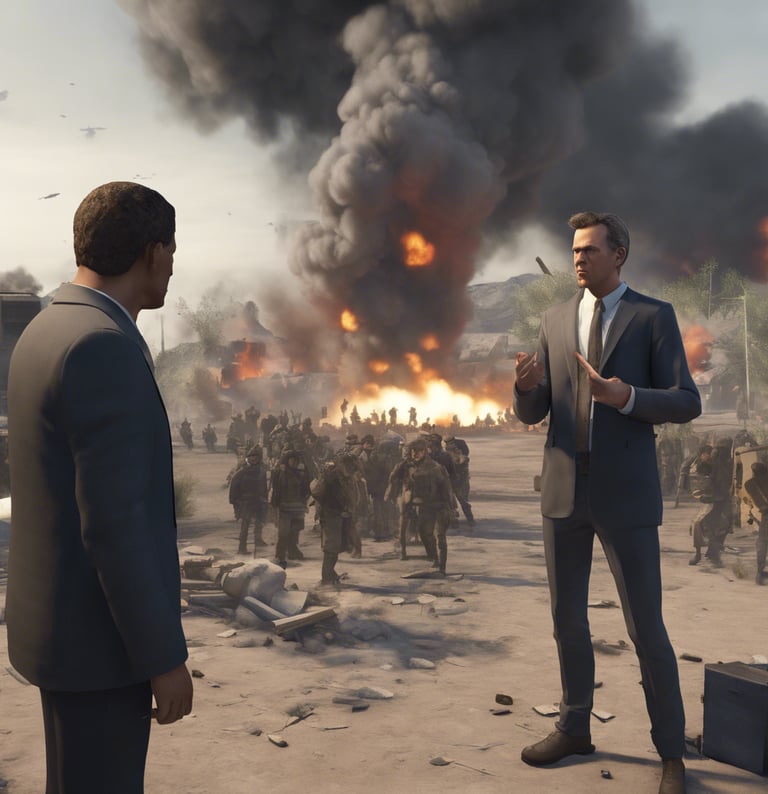Enhancing News Reporting through Interactive Game-Based Simulations: An Exploration of Presence Theory
Presence Theory suggests that the sense of 'being there' in a mediated environment enhances the user’s involvement and immersion, significantly affecting their perception and retention of information. By creating a simulated, interactive representation of real-world events, users can navigate through the incident’s location, witnessing the unfolding of events such as military aircraft, armored vehicles, gangs, or police forces in real-time
SPRING QUARTER 2024
6/19/20243 min read


In this era of rapid evolution of information consumption and rapid synthesis, new inventive ways to media-deliver news are needed more than ever for it's textual and video limitations. The user should be able to see, and participate in news in a way they feel more immersed in than videos and often boring text can provide. In this essay, I will be exploring new developments in real-world events that promise to deliver immersion to the viewer via an game environment where they explore the incident—disaster— or crime scene as if inside a third-person shooter game. With the use of Presence Theory, it's promises to make users more connected and makes news makes like an immersive video-game.
Presence Theory maintains that the simulation of ‘being there’ increases a user’s engagement with and immersion in a mediated environment, with significant implications for attention, learning and recollection. Driven by time-synchronised sensor data, the simulator produces a live and interactive representation of events, where users can traverse through the space of incident in real-time, observing events such as military aircraft, armoured vehicles, gangs or police units unfolding on-screen. This feeling of being there increases understanding, compared with more traditional news mediums.
Several important components are connected to attempting to align news production with video-game development under the auspices of Presence Theory:
Accuracy and objectivity: The simulation must mimic the geographical and contextual details of the event. In order for news to keep its integrity even in a simulated environment, high-fidelity models and faithful representations of the environment, characters and incidents are crucial.
Interactivity and Exploration Different to passive news consumption, the format demands to allow the user to explore and interact with the environment in an active way. The ability to move from one environment to another, look away, examine and rotate the object, and interact with perceived artefacts are tangible ways of increasing the mediated presence.
Narrative Integration: To preserve news’s informative dimension, the narrative should embed into the dynamic experiential environment: context-relevant data could come, among other things, via in-world prompts, character interactions, or navigational cues to sustain an interactive, information-giving spiral.
User Engagement: Enhanced gamification can improve engagement: challenges such as points of interest, interactive hot spots and mission-style objectives gets users exploring their environment more thoroughly and increases their retention of information about the event.
Feasibility In Terms Of Technology: Because this is a concept that relies so heavily on cutting-edge technologies like virtual reality (VR) and augmented reality (AR), participants will presumably experience greater levels of presence if these technologies are more immersive and more interactive.
Ethics: Technical execution is important, but ethical integrity is paramount. The simulation must respect the sensitivities of ongoing and post-end events, and their impacts on localised communities, to represent them responsibly and respectfully.
This hybrid game-based reporting model could change the consumption of news if mixing news reporting and video game development was made to work. For example, interactive game-based simulations have more potential to convey information more vividly and more memorably through greater engagement and immersion compared with other types of news reporting. The game-based simulation approach guided by Presence Theory can not only offer news consumers a fresh form of experience, but also help the audiences to show higher comprehension of complicated events through a more dynamic form than before.
Lombard, M., & Ditton, T. (1997). At the heart of it all: The concept of presence. Journal of Computer-Mediated Communication.
Steuer, J. (1992). Defining virtual reality: Dimensions determining telepresence. Journal of Communication.
Biocca, F., & Levy, M. R. (1995). Communication in the age of virtual reality. Routledge.
Slater, M., & Wilbur, S. (1997). A framework for immersive virtual environments (FIVE): Speculations on the role of presence in virtual environments. Presence: Teleoperators & Virtual Environments.
McLuhan, M. (1964). Understanding Media: The Extensions of Man. MIT Press.
Ryan, R. M., & Deci, E. L. (2000). Intrinsic and extrinsic motivations: Classic definitions and new directions. Contemporary Educational Psychology.
Sundar, S.S. (2008). The MAIN Model: A heuristic approach to understanding technology effects on credibility. In Digital Media, Youth, and Credibility.
Zillmann, D., & Bryant, J. (1985). Selective exposure to communication. Lawrence Erlbaum Associates.
Bogost, I. (2007). Persuasive Games: The Expressive Power of Videogames. MIT Press.
Jenkins, H. (2006). Convergence Culture: Where Old and New Media Collide. NYU Press.



